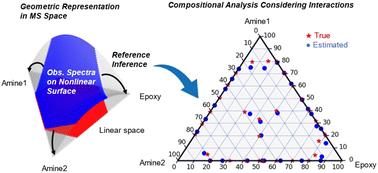Our official English website, www.x-mol.net, welcomes your
feedback! (Note: you will need to create a separate account there.)
Reference-free quantitative mass spectrometry in the presence of nonlinear distortion caused by in situ chemical reactions among constituents
Analyst ( IF 3.6 ) Pub Date : 2024-09-13 , DOI: 10.1039/d4an00961d Yusuke Hibi
Analyst ( IF 3.6 ) Pub Date : 2024-09-13 , DOI: 10.1039/d4an00961d Yusuke Hibi

|
Materials performance is primarily influenced by chemical composition, making compositional analysis (CA) essential in materials science. Traditional quantitative mass spectrometry, which deconvolutes analyte spectra into reference spectra, struggles with reactive systems where spectral variations occur, such as peak shifts and new peak emergences. Additionally, obtaining reference spectra for all pure constituents is often impractical. To address these challenges, I propose nonlinear reference-free quantitative mass spectrometry (NL-RQMS). This method simultaneously determines composition, reference spectra, and nonlinear interaction effects directly from a spectral dataset of mixtures, eliminating the need for prior reference spectra. In a benchmark test on ternary reactive polymers of epoxy and amines, NL-RQMS inferred compositions with an error margin of just 3 wt%, significantly outperforming the 6 wt% error margin of linear RQMS. The inferred interaction terms clearly indicate in situ reactions between epoxy and amine moieties. This framework enables accurate compositional analysis without prior knowledge of the constituents, even in systems with interactive components, and holds significant potential for applications such as grading recycled plastics, where pristine materials, degradation compounds, and stabilizers interact complexly, causing nonlinear spectral distortions.
中文翻译:

在成分之间的原位化学反应导致非线性失真的情况下进行无参考定量质谱分析
材料性能主要受化学成分的影响,因此成分分析 (CA) 在材料科学中至关重要。传统的定量质谱法将分析物谱图解卷积为参比谱图,而在发生谱图变化(如峰偏移和新峰出现)的反应系统中表现不佳。此外,获得所有纯成分的参考光谱通常是不切实际的。为了应对这些挑战,我提出了非线性无参考定量质谱法 (NL-RQMS)。该方法直接从混合物的光谱数据集中同时确定成分、参比光谱和非线性相互作用效应,无需事先获得参比光谱。在对环氧树脂和胺类三元反应聚合物的基准测试中,NL-RQMS 推断出的成分误差幅度仅为 3 wt%,明显优于线性 RQMS 的 6 wt% 误差幅度。推断的相互作用项清楚地表明了环氧树脂和胺基团之间的原位反应。该框架无需事先了解成分即可进行准确的成分分析,即使在具有交互式组件的系统中也是如此,并且在再生塑料分级等应用中具有重要潜力,其中原始材料、降解化合物和稳定剂复杂相互作用,导致非线性光谱失真。
更新日期:2024-09-13
中文翻译:

在成分之间的原位化学反应导致非线性失真的情况下进行无参考定量质谱分析
材料性能主要受化学成分的影响,因此成分分析 (CA) 在材料科学中至关重要。传统的定量质谱法将分析物谱图解卷积为参比谱图,而在发生谱图变化(如峰偏移和新峰出现)的反应系统中表现不佳。此外,获得所有纯成分的参考光谱通常是不切实际的。为了应对这些挑战,我提出了非线性无参考定量质谱法 (NL-RQMS)。该方法直接从混合物的光谱数据集中同时确定成分、参比光谱和非线性相互作用效应,无需事先获得参比光谱。在对环氧树脂和胺类三元反应聚合物的基准测试中,NL-RQMS 推断出的成分误差幅度仅为 3 wt%,明显优于线性 RQMS 的 6 wt% 误差幅度。推断的相互作用项清楚地表明了环氧树脂和胺基团之间的原位反应。该框架无需事先了解成分即可进行准确的成分分析,即使在具有交互式组件的系统中也是如此,并且在再生塑料分级等应用中具有重要潜力,其中原始材料、降解化合物和稳定剂复杂相互作用,导致非线性光谱失真。






























 京公网安备 11010802027423号
京公网安备 11010802027423号